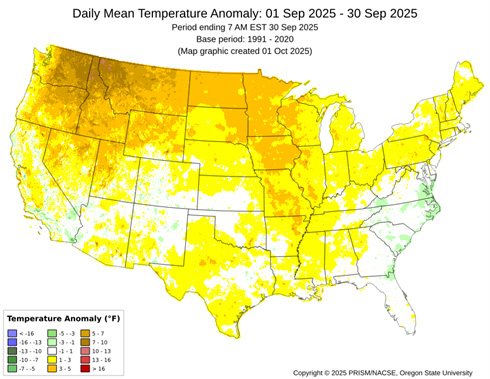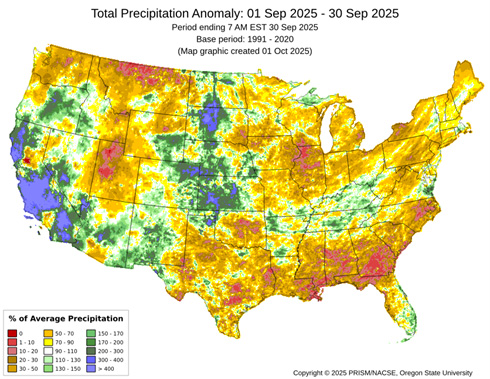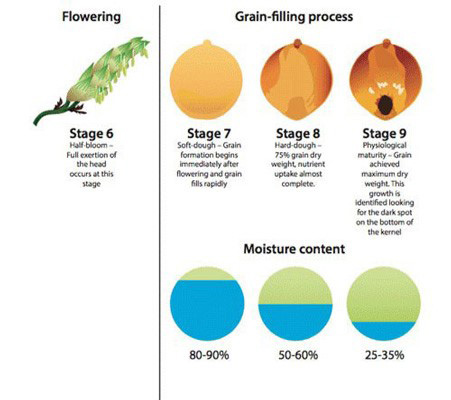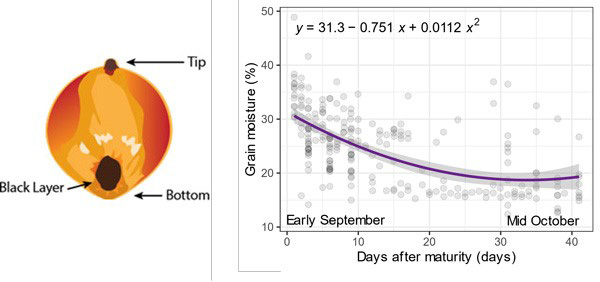In recent years, a common question from farmers has been related to the dry down rate for sorghum as the season approaches its end. Based on previous information, the average dry down rate depends on weather, primarily temperature and moisture conditions; however, modern hybrid data are limited.
The latest Crop Progress and Condition report from Kansas Agricultural Statistics, on September 28, stated that grain sorghum maturity was 48%, behind the 58% last year, but near the average (52%). Harvest is at 7% this year, behind last year (16%) and the 5-year average (12%).
Recent Temperature and Precipitation Patterns
The weather conditions experienced from early September to early October are critical for sorghum as they are related to the grain-filling rate and the determination of final grain weight. While the month of September began with very unseasonably cool conditions, warmer temperatures towards the end of the month resulted in average to slightly above-average temperatures (Figure 1, top map). Temperatures ranged as high as 97° to as low as 42°F during the period.
Localized, very heavy precipitation in some areas, primarily central and southwest Kansas, resulted in these locations observing 200-400% of normal rainfall (Figure 1, bottom map). A significant amount of this rain ran off, resulting in isolated flooding. However, many wet areas have observed recurring timely moisture that has yielded good soil moisture profiles in these locations. Other areas, such as far eastern Kansas, were much drier than normal and observed some drought expansion. Despite the overall wetter-than-normal conditions for September on average, a much warmer/drier end to the month occurred than what the final monthly average statistics would support. This has been particularly timely for regions of the state that have been experiencing wet conditions (central/west), but it has compounded the dryness along the Missouri border. Still, wet areas continue to experience increased dew, humidity, and periods of fog due to the moist soils resulting from previous precipitation events.


Figure 1. Departure from normal temperatures (top map) and percent of normal precipitation (bottom map) from September 1 – 30, 2025. Maps by PRISM.
In recent years, a common question from farmers has been related to the dry down rate for sorghum as the season approaches its end. Based on previous information, the average dry down rate depends on weather, primarily temperature and moisture conditions; however, modern hybrid data is limited.
Weather Outlook for October and November
The weather outlook for the remainder of October favors continued (but moderated) above-normal temperatures and above-normal moisture. As the calendar turns to November, drier-than-normal conditions are expected to materialize. Average precipitation is decreasing each month. Drier-than-normal conditions in November could potentially yield much more limited rainfall, favoring a faster dry down rate. Additionally, warmer-than-normal temperatures favor a later-than-normal freeze, which may be more effective at drying down, especially when combined with drier conditions in November.
Growing Degree Days and Crop Maturity
From a crop perspective, the overall cumulative GDD from flowering to maturity is about 800-1200 (based on 50°F as the base temperature), with the shortest requirement in GDD for short-season hybrids. Before maturity, from the beginning of grain filling (soft dough until maturity), grain moisture content within a grain will go from 80-90% to 25-35%, where black-layer is usually formed (Figure 2). From maturity (seen as a “black-layer” near the seed base; Figure 2) to harvest time, sorghum grain will dry down from about 35 to 20% moisture, but the final maximum dry mass accumulation and final nutrient content will have already been attained at maturity.

Figure 2. Sorghum growth stages from half-bloom and grain filling (including soft dough, hard dough, and physiological maturity). Infographic representing changes in grain coloration and moisture content during the grain filling period until black layer formation (maturity). For further reference on sorghum growth and development please check: https://bookstore.ksre.ksu.edu/pubs/MF3234.pdf. Graphic by K-State Research and Extension.
Dry down process for grain sorghum
Grain water loss occurs at different rates but with two distinct phases: 1) before “black-layer” or maturity (Figure 2), and 2) after black-layer. For the first phase, Figure 2 illustrates the changes in grain moisture from soft dough to physiological maturity in sorghum.
To answer the rate of dry down question, a study was conducted to investigate the effect of the grain dry down rate from the moment of “black-layer” until commercial harvest grain moisture is reached. For the conditions experienced in 2019, 2021, and 2022 (from early September until mid-October), the overall dry-down rate was around 0.7% per day (from 31-34% to 16-17% grain moisture), taking an overall of 30 days. This is slower than the average dry rate for corn (1%) and for soybeans (3%).

Figure 3. Grain moisture dry down across different sorghum hybrids for a study near Manhattan, KS (2019, 2021, and 2022 growing seasons). The graphic in the left panel illustrates the black layer stage of grain for sorghum. Graphics from K-State Research and Extension.
This dry down process can be delayed by:
- Low temperatures
- High humidity
- High grain moisture content at black layer (38-40%)
It is expected that the dry down rate will decrease to around<0.5% per day for late-planted sorghum entering reproductive stages later in the growing season. A similar decrease is also expected for sorghum that was exposed to late-season stress conditions (e.g., drought, heat, and freeze). Under these conditions, maturity may be reached with high grain water content, and the last stages after black layer formation could face lower temperatures and higher humidity. These main factors should be considered when it is time to harvest.
You can track temperature and humidity levels on the Kansas Mesonet website at http://mesonet.k-state.edu/weather/historical/ by selecting the station and time period of interest.
Lucas Haag, Agronomist-in-Charge at Tribune
lhaag@ksu.edu
Logan Simon, Southwest Area Agronomist
lsimon@ksu.edu
Tina Sullivan, Northeast Area Agronomist
tsullivan@ksu.edu
Jeanne Falk Jones, Northwest Area Agronomist
jfalkjones@ksu.edu
Christopher “Chip” Redmond, Kansas Mesonet Manager
christopherredmond@ksu.edu
Tags: drydown sorghum grain sorghum harvest